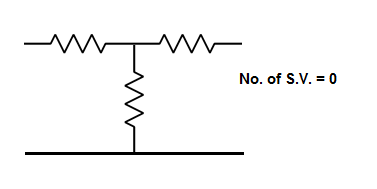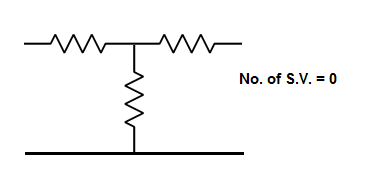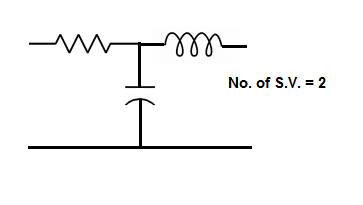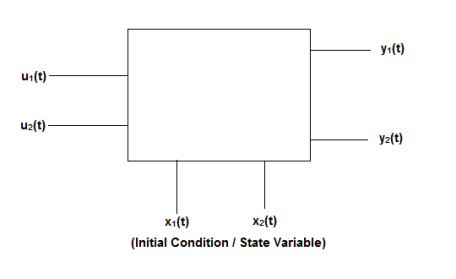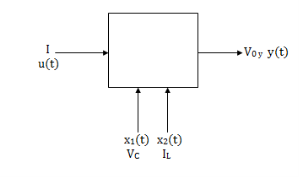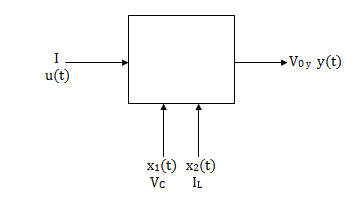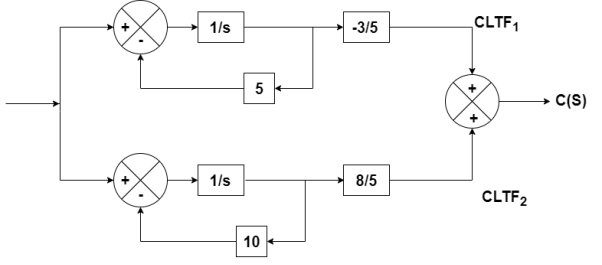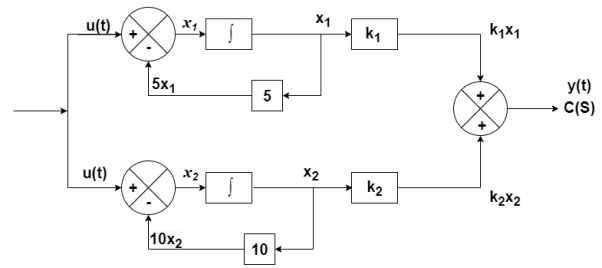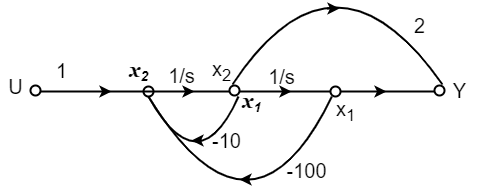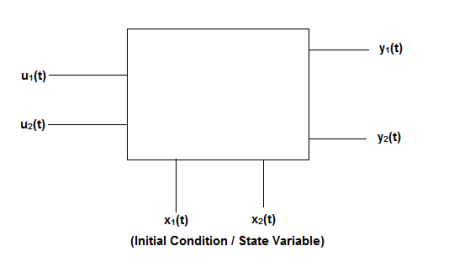UNIT -3
Modelling in Time domain
The state of a system is a minimal set of variables known as state variables. The knowledge of these variables at any instance of time together with the knowledge of the inputs for the same instance of time, determines the complete behaviour of the system. The fewer drawbacks in the transfer function method for representing any system led to the use of state variables in analysis of system. Few advantages are listed below:
- The state space can be used for linear or nonlinear, time-variant or time-invariant systems.
- It is easier to apply where Laplace transform cannot be applied.
- The nth order differential equation can be expressed as 'n' equation of first order.
- It is a time domain method.
- As this is time domain method, therefore this method is suitable for digital computer computation.
- On the basis of the given performance index, this system can be designed for an optimal condition.
Representation of state space: The system shown below has ‘m’ inputs, ‘p, outputs and ‘n’ number of state variables. The state equation gives us the relation between the state variables and the inputs.
|
Fig 1 Representation of State space
So, the above system shown can be described through equations as
The above set of equations can be represented as
As we are concerned for time invariant system, for which the term
The above equation can be represented in matrix form as given below
The above coefficients aij and bji in equation (4) can be written in vector matrix form as
The output of the system can be represented by linear combination of state variables and inputs. y1=c11x1(t)+c12x2(t)+…….+c1nxn+d11u1+………..+d1mum y2=c21x1(t)+c22x2(t)+…….+c2nxn+d21u1+………..+d2mum yr=cr1x1(t)+cr2x2(t)+…….+crnxn+dr1u1+………..+drmum (6) The equation (6) can be represented in matrix form as Where coefficients cij and dji are constants. The output equation is given as Y=CX+DU (8) |
Key takeaway
- The state equation is given as
 =Ax(t)+Bu(t)
=Ax(t)+Bu(t) - The output equation is given as Y=CX+DU
The state variables selected here are the physical quantities of the system, which can be measured. The selection of these variables can be directly related to the physical system because the solution of state equation is related to the time variation of the system variables.
The number of energy storing elements in any system is equal to the number of state variables. Below shown are few electrical circuits, just to brush up the concept of energy storing elements and state variable relation.
|
|
|
Fig 2 Electrical Circuits with energy storing elements
Now calculating the state equation and output equation for state variable analysis.
State Equation and Output equation:
Number of output=Number of output equation
|
Fig 3 State Model
Considering multiple input and multiple output system, with two inputs u1(t)and u2(t), and two outputs y1(t) and y2(t) respectively.
y1(t)=c11x1(t)+c12x2(t)+d11u1(t)+d12u2(t) y2(t)=c21x1(t)+c22x2(t)+d21u1(t)+d22u2(t)
The output equation is given as Y(t)=CX(t)+DU(t) Y(t)= C= U(t)= # Now finding State Equation Number of energy storing elements= Number of state variables
The state equation is then given as
|
Key takeaway
- The number of energy storing element= Number of state variables
- We should always take voltage across the inductor L, and current through capacitor C.
Example-1: Obtatin the state space representation for the given electircal system
|
Solution: The state model is given as
|
Fig 4 State Model
The state model shows that there are two energy storing elements L, C. As we already know that Number of state variables is equal to the number of energy storing elements.Hence we have two state variables[x1(t) and x2(t)]. We have one output V0(taken across capacitor) and input u(t).
The output equation is then given as
Y(t)=CX(t)+DU(t) V0=Vc= x1(t) ….(a) Hence output equation becomes V0= x1(t) y(t)=[1 0] so, C=[1 0] D=[0] Now writing the state equation
For that applying KVL in the above circuit V=ILR+L State Equation is
x1(t)=Vc
IL=C
VL=L
From KVL L
From equation (b) and (c)
Now writing the state equation
Hence A= |
Example-2 Obtatin the state space representation for the given electircal system
|
Solution: The state model shows that there are two energy storing elements L, C. As we already know that Number of state variables is equal to the number of energy storing elements.Hence we have two state variables[x1(t) and x2(t)]. We have one output V0(taken across capacitor) and input u(t).
|
Fig 5 State Model
Here output is V0. But from above electrical circuit V0=ILR
V0=x2(t)R y(t)= V0= [0 R] The output equation is given as Y(t)=CX(t)+DU(t) C=[0 R] D=[0] Now finding state equation,we apply KCL in the given electrical circuit I=IC+IL
But I-IL=IC
Applying KVL in the given electrical circuit we get VC=VL+ILR VC-ILR=VL=L
From equation (b) and (c) we have Now writing the state equation
Hence A= |
Key takeaway
We should always take voltage across the inductor L, and current through capacitor C.
Calculation of state model from Transfer function
This can be implemented by three ways as listed below:
a) By Block diagram method (Jordan’s Canonical form)
b) By Signal flow graph
c) By differential equation
By Block diagram method (Jordan’s Canonical form)
Q1) The closed loop transfer function is given as T(s)= . Calculate the state model?
. Calculate the state model?
Sol: The transfer function can be simplified using partial fraction method as
S+2=As+10A+Bs+5B Equating coefficients of s from both sides A+B=1 Equating coefficients of s0 from both sides 10A+5B=2 Solving above equations we get A=-3/5 B=8/5 The transfer function will be T(s)= =- |
|
Number of poles= Number of energy storing elements
|
Fig 6 Block Diagram for T(s)=
The output equation is given as
y(t)=k1x1(t)+k2x2(t) y(t)= [k1 k2] y(t)= [-3/5 8/5] C=[-3/5 8/5] D=0 From the above block diagram
Therefore, the state equation is given as
A= B= |
Q2) The closed loop transfer function is given as T(s)= . Calculate the state model?
. Calculate the state model?
Sol: The transfer function can be simplified using partial fraction method as
s+7=A[s2+7s+12] +B[s2+6s+8] +C[s2+5s+6] Equating coefficients of s2 from both sides A+B+C=0 Equating coefficients of s from both sides 7A+6B+5C=1 Equating coefficients of s0 from both sides 12A+8B+6C=7 Solving above equations and finding values of A, B and C A=5/2 B=-4 C=3/2 The transfer function will be T(s)= = |
|
Fig 8 Block Diagram for T(s)=
The output equation will be
y=k1x1+k2x2+k3x3 y=[k1 k2 k3] C=[5/2 -4 3/2] D=[0] The state equation is given as
Therefore
A= B= |
Inferences from the above matrices (Jordan’s canonical form)
- Matrix [A] is diagonal matrix and the diagonals are closed loop poles.
- Matrix [B] is always of the form

- Matrix [C] contains residue of poles
- Matrix [D] is always zero When number of poles ≠ number of zeros
- When number of poles = number of zeros only change comes in matrix [D]. It is the ratio of coefficient of highest power of s in closed loop transfer function.
Q3) The closed loop transfer function is T(s)= . Find the state equation?
. Find the state equation?
Sol: Here the number of poles = number of zeros
T(s)= = = =2+ =2+ Solving above by partial fraction method 88= As+2A+Bs+3B A=-B 2A+3B=88 A=-88 B=88 The transfer function becomes T(s)= 2- |
|
|
Fig 9 Block Diagram for T(s)=
The output equation will be
y(t)=2U+k1x1+k2x2 y=[-88 88] The output equation will be
Therefore, the state equation is given as
A= B= |
b) By signal flow graph
The transfer function id given as T= |
Limitations:
1)  =1 for all k
=1 for all k
2) All loops should be touching
Number of terms in numerator= Number of forward paths
Number of terms in denominator= Number of loops
Q1) The CLTF T(s)= Sol: T(s)= = P1=2/s P2=-8/s2 L1=-10/s L2=-100/s2
Fig 9 SFG for T(s)= The state equation will be
|
C) By using differential equation:
Q1) Find the state equation from the given differential equation |
Sol: Let y=x1
The above differential equation than becomes
Hence the state equation will be
|
|
Fig 10 State model
The above figure shows the state model of a system with two inputs u1(t) and u2(t), and having outputs y1(t) and y2(t). We know that the output equation is given as
Y(t)=Cx(t)+Du(t) (9) Taking L.T of equation (9) Y(s)=CX(s)+DU(s) (11) Taking L.T of equation (10) SX(s)=AX(s)+BU(s) (12) X(s)=[SI-A]-1BU(s) (13) Y(s)=CX(s)+DU(s) Y(s)=C{[SI-A]-1BU(s)} + DU(s)
[SI-A]-1= The denominator of equation (14) is the characteristic equation [SI-A]=0 |
Example-1 For the given data below compute the transfer function of the system
A= B=
B= C=[1 0] and D=[0]
C=[1 0] and D=[0]
Sol: The state equation will be
From Equation (14)
=C{ =C =[1 0] =
|
References:
1. “Control System Engineering”, Norman S. Nise,John willey and Sons, 6th Edition, 2015.
2. “Control System Engineering”,I.J. Nagrath and M. Gopal,New age International publication, 5th Edition, 2014.
3. “Modern Control Engineering”, Katsuhiko Ogata,Prentice Hall of India Pvt
Ltd, 5th edition.
4. “Automatic Control System”, Benjamin C. Kuo, Prentice Hall of India Pvt Ltd, Wiley publication, 9th edition













